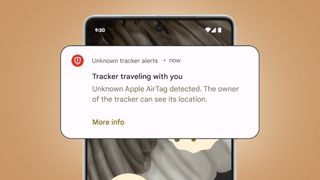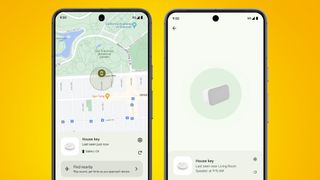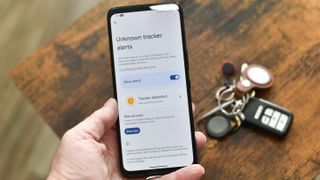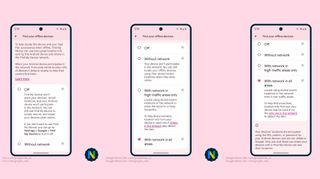Google‘s Find My Device network for Android devices just got a massive upgrade, with the tech giant’s “all-new” system for finding lost devices rolling out worldwide from April 8, starting with the US and Canada.
But wait, didn’t Find My Device already exist? Yes, but this upgraded version is a different beast and much more like Apple‘s powerful, crowdsourced Find My system for iPhones and AirTags.
In short, Google’s previous Find My Device service let you find your Android phone, if it was connected to the internet. But the new one will let you locate almost anything, whether it has internet and location capabilities or not.
The new Find My Device network was announced at Google IO 2023, but has now finally started rolling out after Google spent some extra development time working on data privacy and security (and also potentially waiting for Apple to finalize its specs for cross-platform tracking).
This new-and-improved network works with Bluetooth trackers (such as Chipolo and, perhaps one day, a Google AirTags device), and can use the billions of Android devices across the world to help locate lost objects that have such a tracker attached, as well as lost phones.
This will potentially make Android’s Find My Device network even bigger and more capable than Apple’s Find My network. Here’s everything we know about the new tracking service so far.
Android Find My Device network: what is it?

Google’s Find My Device network has been around for years, albeit in much more limited form. If you’ve been an Android user for any length of time then you’ve probably interacted with it. But in its previous form it wasn’t a ‘network’, as it didn’t leverage millions of other Android devices to help you find lost objects.
With the new Find My Device network it does, and this update also adds support for various Bluetooth trackers (such as those from Tile, Chipolo, and Pebblebee), as well as some other devices, such as Pixel Buds, and headphones from Sony and JBL.
Additionally, Find My Device lets you detect unwanted AirTags and other trackers (in other words ones that someone might have hidden in your belongings in order to stalk you). In all, this is the biggest update to Find My Device since the service’s original launch back in 2017.
Android Find My Device network: when did it relaunch?
The “all-new’ Find My Device network started rolling out to Android devices around the world from April 8, starting in the US and Canada.
Google originally planned to launch its new Find My Device network in summer 2023, but in a Google blog post from late July, the company revealed that it was delaying the launch.

It made this decision because it wanted to wait until Apple fully rolled out unknown tracker alerts to its own Find My service. Currently, if you have an iOS device, you can get alerts for unknown AirTags and third-party, Find My-certified Bluetooth trackers, but not for those that aren’t certified on Apple’s proprietary Find My network. But this is about to change from iOS 17.5.
Unusually, Google and Apple have been jointly working on these cross-platform unwanted tracker alerts, so they can be sent across Android and iOS platforms.
Android Find My Device network: how does it work?
Previously, if you lost your Android phone then – assuming you’d enabled Find My Device – you’d be able to see its last known location on a map. If it was online with location services enabled, then that location should have been up to date. But it was offline, then you’d have been out of luck – and this is one of the key differences with Google’s new network.
Because it uses an anonymous, crowdsourced network of other Android devices (in the same way as Apple’s Find My network), you should be able to find your phone’s location even if it’s offline. If you have a Google Pixel 8, you can even find those phones when they’re powered off – with Google telling Android Authority that his feature will be coming to other Android phones, although it hasn’t specified which.

The old Find My Device network needed your device to be online for an up-to-date location, and only worked with select devices (like Android phones and Wear OS watches). The new Find My Device network has none of these limitations.
For one thing, it will work with some Bluetooth trackers, including ones from brands like Tile, Chipolo, and Pebblebee. This means that, even if the thing you want to track doesn’t work directly with Find My Device (for example if it’s a wallet or your keys), you’ll be able to attach a Bluetooth tracker and track it that way.
Items also don’t need an internet connection or location services to be trackable, as other peoples’ Android devices on the Find My Device network will be able to locate them if they’re within Bluetooth proximity, so you can see their approximate location on a map. Given how many Android devices there are out in the world (over a billion), it’s likely that this network will be able to locate missing items pretty much anywhere.
It’s a similar idea to what Apple’s Find My network already does, and Google states that as with Apple’s network, the location information is encrypted, meaning that no one other than you – not even Google itself – can tell where your tracked items are located.

The other part of this big Find My Device update is alerting you to unknown trackers that might be used to stalk you. We’ll explain how you set this up below, but once it’s up and running, your Android phone will automatically send you a notification if an unknown tracker is detected to be traveling with you.
You can also perform a manual scan, and it detects unknown trackers (such as an AirTag or Tile tracker) by scanning Bluetooth for any unknown trackers that have been traveling with you. That last point is how it differentiates a Bluetooth tracker that’s tracking you, from one that just happens to be in the vicinity (as there might be when you’re around other people).
If an unknown tracker is ever detected, you’ll be shown a map complete with where the tracker was first detected and the path it’s followed you on. You’ll also have the option to play a sound on it so you can more easily locate it, and be given instructions on how to disable it.
That said, this feature can initially only detect AirTags (though that will change) and in our anecdotal experience we’ve found Google’s unknown tracker detection feature doesn’t always detect AirTags very quickly, or always successfully play a sound on them, so there may be some bugs to iron out.
Android Find My Device network: how do you set it up?
To use the new Find My Device network, you’ll need a phone that’s running Android 9 or above. Got one of those? It’s then just a case of following a few steps to set up your device, so it’s findable if you lose it.
Firstly, make sure you’re signed into your Google account (in Settings > Google), checking that Location sharing is on (Settings > Location > turn on), and making sure that Find My Device is on (Settings > Google > All Services > Find My Device).
This is also where you can opt out of being part of Google’s Find My Device network. Tap ‘Find your offline devices’ in the ‘Find My Device’ menu and you can choose ‘off’, which means your device’s encrypted recent locations won’t be stored and you won’t participate in the network.
If you’re happy to be part of the network and have followed all of the steps above, you can check to see it’s working by going to android.com/find and signing in. It’s then just a case of installing the Find My Device app (if you don’t already have it) and managing your devices in there.

The location of your devices is encrypted, using the PIN, pattern or password of your Android devices, so only you (or those you share your devices with in Find My Device) can view their location.
When first enrolling a device you’ll be prompted to enter the PIN, pattern or password for another of your devices that’s already on the network, so Google can verify it’s you – or if this is your device enrollment, then presumably you’ll have to enter the PIN, pattern or password for that device.
As for the unknown trackers component of this big Find My Device update, this is also available now and should be enabled by default. But to check or to disable it, just head on your phone to Settings > Safety & Emergency (or Settings > Personal Safety if your phone is running Android 11 or older), then scroll down and tap ‘Unknown tracker alerts’.
You’ll then see an ‘Allow alerts’ toggle which should automatically be enabled – you can turn it off if you’d like, but we’d suggest most people leave it on, since it will help prevent stalking attempts. You can also on this screen run a manual scan for trackers near you right now that are separated from their owners.
Android Find My Device network: is Google making AirTag-like trackers?
With Google launching a Find My Device network that works with Bluetooth trackers, it would make sense for it to launch a Bluetooth tracker of its own – something to rival Apple’s AirTag. While this isn’t here yet, reports suggest that it could be in the works.
These Google AirTags might be codenamed ‘grogu’, according to leaker Kamila Wojciechowska, and they’re apparently in development by the Nest team, and will support UWB (Ultra Wideband) and BLE (Bluetooth Low Energy) for tracking their location.
Google’s AirTag-like tracker also apparently has onboard speakers (so it can sound an alert to help you locate it), and is said to come in several different colors. This all comes from one source, so we’d take it with a pinch of salt, but it’s a believable claim.
What’s not clear is when this Bluetooth tracker might launch. It hasn’t arrived yet, even though Google has already switched on its Find My Device network, but it’s possible we could see it land at Google IO 2024.
In the meantime, support for third-party trackers including ones from Chipolo and Pebblebee has been announced, so you don’t need to wait for Google to launch its own version. Chipolo, for example, has announced the Chipolo One Point item trackers and Card Point wallet finders, which are available to pre-order now with shipping after May 27th.
You might also like
Services Marketplace – Listings, Bookings & Reviews
